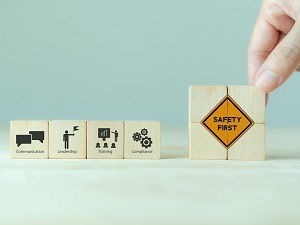Management provides the leadership, vision, and resources that are critically needed to implement an effective safety and health program.

In any organization, management typically refers to the business owners, managers, and supervisors. Effective management leadership, when it comes to workplace safety, means that the leaders of the organization behave in a positive way that promotes health and safety throughout the company.
Management leadership has a responsibility to create a culture of safety by making worker safety and health a core organizational value. To do this, management staff must be fully committed to eliminating hazards, protecting workers, and continuously improving workplace safety and health, even when things get tough, finances get tight, growth happens quickly, or production is maximized.
Management personnel should be setting an example for all workers through their own actions and by visibly demonstrating and communicating their safety and health commitment throughout the organization. A great way management can set the precedent that safety is important is by providing sufficient resources to implement and maintain the safety and health program.

A clear, written safety policy helps management leadership communicate that safety and health is a primary organizational value—as important as productivity, profitability, product or service quality, and customer satisfaction.
Organizations should establish a written safety policy signed by top management describing the organization’s commitment to safety and health and pledging to establish and maintain a safety and health program for all workers.
Once the policy is drafted and signed, management can communicate the policy to all workers and relevant parties including employees, contractors, staffing agencies, new and temporary workers, suppliers, and vendors, as well as visitors and customers.
When management has set safety standards for the organization, leadership staff should set a good example and follow the same safety procedures required of the workers. Safety and health should also be a considering factor in all business decisions, including contractor and vendor selection, purchasing, and facility modification.

By establishing specific goals and objectives, management sets expectations for managers, supervisors, and workers, and for the program overall. The goals and objectives should focus on specific actions that will improve workplace safety and health.
There should be realistic, measurable goals set for improving safety and health within the organization. Instead of focusing on injury and illness rates, goals emphasizing injury and illness prevention are preferred.
Management can develop plans to achieve the safety goals by assigning tasks and responsibilities to particular people, setting timeframes, and determining resource needs.

Management provides the resources needed to implement the safety and health program, pursue program goals, and address program shortcomings when they are identified.
Resources needs will of course vary depending on the organization’s size, complexity, and hazard types. Resources for safety and health program development may include capital, equipment, supplies, staff time, training, access to information and tools, and access to safety and health experts.
After estimating and allocating the resources needed to establish and implement a safety program, management must allow time in workers’ schedules for them to fully participate in the program. Safety and health should not be an afterthought, but rather should be integrated into planning and budgeting processes of the company.
Management leadership is responsible for providing and directing resources to operate and maintain the safety and health program, meet the commitments that have been set, and then further pursue the program goals.

Once the safety and health program is established, management leadership has the right to expect performance. Management will lead the program effort by establishing roles and responsibilities and providing an open, positive environment that encourages communication about safety and health.
There is typically a safety department manager or safety team that leads the safety program effort, makes plans, coordinates activities, and tracks progress. This person or group becomes the bridge between management leadership and employees.
Management can provide positive recognition for meeting or exceeding safety and health goals aimed at preventing injury and illness, which may include actions like reporting near misses, attending training, and conducting inspections. Successful programs reward, rather than discipline, workers who identify problems or concerns.
Maintaining a positive and encouraging tone is important. A successful safety and health program establishes ways for anyone in the organization to communicate freely about safety and health issues, without fear of retaliation.

For more information on how to evaluate and improve your workplace safety and health program, download a copy of OSHA’s booklet Recommended Practices for Safety and Health Programs.
.jpeg)

